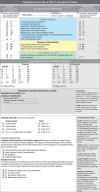Intrahepatic cholangiocarcinoma: expert consensus statement
- PMID: 26172134
- PMCID: PMC4527852
- DOI: 10.1111/hpb.12441
Intrahepatic cholangiocarcinoma: expert consensus statement
Abstract
An American Hepato-Pancreato-Biliary Association (AHPBA)-sponsored consensus meeting of expert panellists met on 15 January 2014 to review current evidence on the management of intrahepatic cholangiocarcinoma (ICC) in order to establish practice guidelines and to agree on consensus statements. The treatment of ICC requires a coordinated, multidisciplinary approach to optimize survival. Biopsy is not necessary if the surgeon suspects ICC and is planning curative resection, although biopsy should be obtained before systemic or locoregional therapies are initiated. Assessment of resectability is best accomplished using cross-sectional imaging [computed tomography (CT) or magnetic resonance imaging (MRI)], but the role of positron emission tomography (PET) is unclear. Resectability in ICC is defined by the ability to completely remove the disease while leaving an adequate liver remnant. Extrahepatic disease, multiple bilobar or multicentric tumours, and lymph node metastases beyond the primary echelon are contraindications to resection. Regional lymphadenectomy should be considered a standard part of surgical therapy. In patients with high-risk features, the routine use of diagnostic laparoscopy is recommended. The preoperative diagnosis of combined hepatocellular carcinoma and cholangiocarcinoma (cHCC-CC) by imaging studies is extremely difficult. Surgical resection remains the mainstay of treatment, but survival is worse than in HCC alone. There are no adequately powered, randomized Phase III trials that can provide definitive recommendations for adjuvant therapy for ICC. Patients with high-risk features (lymphovascular invasion, multicentricity or satellitosis, large tumours) should be encouraged to enrol in clinical trials and to consider adjuvant therapy. Cisplatin plus gemcitabine represents the standard-of-care, front-line systemic therapy for metastatic ICC. Genomic analyses of biliary cancers support the development of targeted therapeutic interventions.
© 2015 International Hepato-Pancreato-Biliary Association.
Figures
Comment in
-
Consensus conference on intrahepatic cholangiocarcinoma.HPB (Oxford). 2015 Aug;17(8):661-3. doi: 10.1111/hpb.12438. HPB (Oxford). 2015. PMID: 26172131 Free PMC article. No abstract available.
References
-
- Dodson RM, Weiss MJ, Cosgrove D, Herman JM, Kamel I, Anders R, et al. Intrahepatic cholangiocarcinoma: management options and emerging therapies. J Am Coll Surg. 2013;217:736–750. e4. - PubMed
-
- Maithel SK, Gamblin TC, Kamel I, Corona-Villalobos CP, Thomas M, Pawlik TM. Multidisciplinary approaches to intrahepatic cholangiocarcinoma. Cancer. 2013;119:3929–3942. - PubMed
-
- Luo X, Yuan L, Wang Y, Ge R, Sun Y, Wei G. Survival outcomes and prognostic factors of surgical therapy for all potentially resectable intrahepatic cholangiocarcinoma: a large single-center cohort study. J Gastrointest Surg. 2014;18:562–572. - PubMed
-
- Gleeson FC, Rajan E, Levy MJ, Clain JE, Topazian MD, Harewood GC, et al. EUS-guided FNA of regional lymph nodes in patients with unresectable hilar cholangiocarcinoma. Gastrointest Endosc. 2008;67:438–443. - PubMed
-
- Levy MJ, Heimbach JK, Gores GJ. Endoscopic ultrasound staging of cholangiocarcinoma. Curr Opin Gastroenterol. 2012;28:244–252. - PubMed
Publication types
MeSH terms
LinkOut - more resources
Full Text Sources
Other Literature Sources
Medical
Miscellaneous


